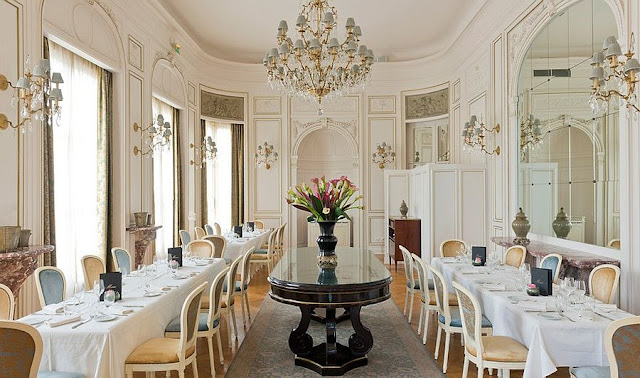The Art of Laying the Table the French Way - Part Two
Last week, in Part One we talked about cutlery and glasses. Today in Part Two, we are talking about linen and some addition touches to make your table setting that extra bit special. Today's tips are courtesy of French Boyfriends Aunt, who's husband was a French Ambassador and as a result, they spent a lot of time hosting chic dinner parties.
Table linen
To start off well, lay out a smooth, ironed tablecloth on the table without the slightest crease.
It should fall all around the table to about a foot from the ground.
If you don't have a large enough tablecloth, use 2 or 3 tablecloths but avoid joins in the middle of the table.
Napkins should be placed to the left of the plates, near the cutlery. Make sure they are impeccably ironed. If you are setting a very elegant table for a special occasion, opt for cloth napkins to match the tablecloth.
Note also that tableware purists are not really keen on napkins in glasses or placed on plates.
The plates
In order to be comfortable when seated at the table respect the space between each guest, the ideal being to maintain a distance of 50 cm (30 to 40 cm at least) between the plates.
Start by placing a presentation plate in each place. Nnver put more than two plates on the presentation plates which are removed for the cheese service. Regardless of its size, the plate should be placed approximately 2 cm from the edge of the table.
The 3 plates usually present on a properly set table are as follows:
presentation plate;
flat plate ;
and a soup bowl.
Specific plates such as foie gras or cheese plates can be brought to the table as the meal progresses.
Never put two dinner plates on top of each other! On the other hand, it is quite possible to use silver, gold, glass or varnished wicker sub-plates. Decorative, they will also protect the table from too hot plates.
Plates aside, the only items allowed on the table are the bread basket and, in a pinch, a very large central decorative dish. You are also free to add, why not, some flowers!
At the time of the first service, on the other hand, you can place a soup tureen, a dish or a salad bowl.
Note that when it comes to tableware, it is not recommended to have trivets, especially if you are organizing a high-end meal; which is not necessarily the case for family meals with a more relaxed atmosphere!
Positioning of glasses
You never have less than two glasses on the table. Place at least one water glass (the largest) and one wine glass.
The water glass is in front of the plate and the wine glass is slightly to the right.
If you have champagne flutes and you have an aperitif at the table, these are shown to the left of the water glasses, a little behind.
Be careful not to use colored glasses for wine. In fact, connoisseurs like to observe the color of the wine before tasting it.
If you decorate the table with several glasses, place them in front of the plate, from left to right, from the largest to the smallest:
first the water glass on the left,
then the red wine glass,
then the white wine glass.
Note the cheese knife accompanies the cheese plate and should not be positioned between the glass and the plate at the start of the meal.
The small dessert spoons and forks should be brought with the dessert plates at the end of the meal.
Bread, salt and pepper, cheese, drinks
Finally, you have to finish by setting the table by adding bread, spices and drinks.
At the top left of the plate, a small plate topped with cut bread or mini loaves of different shapes and varieties is sure to delight guests.
Bread can also be presented in one or more large baskets placed at regular intervals in the center of the table. It should be cut straight or bevelled, in slices not too thick and always regular.
Never put bread on the table without cutting it. During lunch or dinner, regularly present diners with the basket full of pieces. Friendliness and respect for the arts of the table oblige.
If the table is large, a salt and pepper shaker will be placed at each end.
As for the wine, it is placed in front of the master of the house or on a piece of furniture placed nearby. If your grand cru was poured into a decanter, leave the bottle in view not far from the table so that diners can learn about the nature of the content being served to them. Always make sure there is a water carafe on the table.
A word on the presentation of the cheeses, which must be present in odd numbers. Except for cooked cheeses, remove the rind to facilitate serving.
Tableware: pay attention to cleanliness!
The cleanliness of the dishes is an essential question in the field of tableware. Poorly cleaned plates, glasses marked with fingerprints and stained napkins or tablecloths have a terrible effect.
As for the glasses, wipe them gently with a fine cloth. If they are imbued with an annoying musty or laundry odor, feel free to re-wash them by hand rather than in the washing machine. Use some
Lastly, a striking candelabrum bearing several candles or a series of smaller candle jars (depending on the size of your table) will provide soft, elegant lighting.
Happy entertaining ♥♥ Leeann x

Comments
Post a Comment